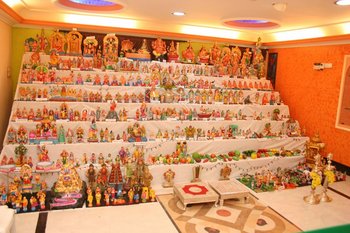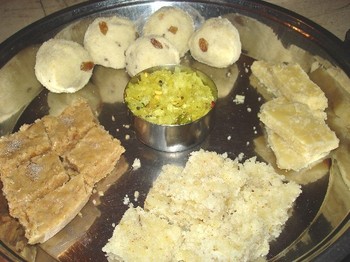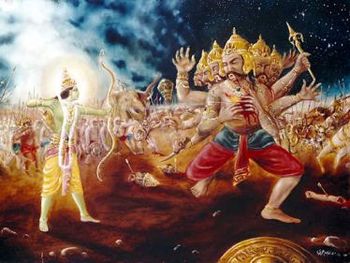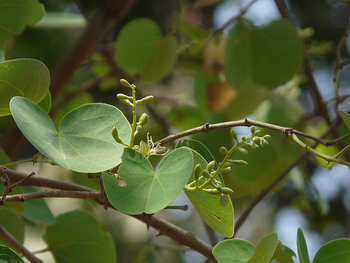Dasara
Dasara (Dussehra, Navaratri) is one of the most famous festivals in India. According to the Hindu calendar it is celebrated on the 10th day of the Shukla Paksha (“bright half”) of the month of Ashvin (Ashwayuja). In the western calendar it is sometime in September or October. In 2014 Dasara is held on the 3rd of October. In some parts of India it is celebrated for 10 days. The word dasara comes from „dashhara“ where „dash“ means ten and „hara“ means defeated.
 Goddess Chamunda
Goddess Chamunda
Dasara celebrates the victory of good over evil. It is celebrated in different ways. It is done through worshipping of the goddess Chamundeshwari (Durga). Chamunda (Chamundi or Charchika) got her name as combination of Chanda and Munda, two monsters she killed. Chamunda is a fearsome aspect of Devi, the Hindu Divine Mother and one of the seven Matrikas (mother goddesses). She is also one of the chief Yoginis, a group of 64 or 81 Tantric goddesses, who are accompanying the warrior goddess Durga.
 Krishna and Gopi with dolls
Krishna and Gopi with dolls
The second way of celebrating Dasara is by exhibiting colourful toys on the day of bombe habba. This tradition is popular in Karnataka. Karnataka is a state of about 53 million people in the south of India. Its capital and biggest city is Bangalore.
 Golu exhibition of dolls and figurines
Golu exhibition of dolls and figurines
Indian states of Tamil Nadu and Kerala organize „Golu“ (Kolu or Bommai Kolu). It is an exhibition of different dolls and figurines. They are arranged in odd (usually 7, 9 or 11) numbered layers („padis“). The Golu Padis are usually covered with a white cloth, decorated with white flowers and other decorations.
 Goddess Durga
Goddess Durga
There is a story about it. The goddess Durga needed extra ordinary power. To help her all other gods and goddesses gave all of their power to Goddess Durga. Without power they all stood still as toys. Out of respect for this act of self-sacrifice people exhibit toys shaped as gods and goddesses.
During Dasara people who have Golu receive many guests. Women wear silk saris (Kancheepuram Pattu Pudavais), jewelry and some jasmine flowers in their hair. Dasara is a chance for kids (younger than 10 years) to dress up in the evening as Krishna, Radha, Andal, Meera, Pattu Mami and other characters.
 Prasad
Prasad
Girls and married women get a prasad (the offering given to God that day), kumkum and a small bag of presents. Prasad or „a gracious gift“ usually includes some flowers, fruits or sweets. Kumkum is a powder, made from turmeric or saffron, which is used for social and religious markings in Hinduism.
In the evenings, people prepare a small lamp or "kuthuvilakku". The lamp is lit in the middle of decorated "kolam" (rangoli). Kolam is kind of sandpainting made every morning from rice flour by women in the family. Kolam is usually made in front of the family house.
 Kolam (rangoli)
Kolam (rangoli)
In the past Kolam was made for birds and other small animals as „invitation“ to enter the house. This was seen as a way to establish harmony among all living beings. Kolam is a sign of welcome for all guests. One more detail about Kolam. Lines in Kolam must be completed. In a symbolic way evil spirits then can not enter the house.
Devotional hymns and shlokas (prayers) are chanted. A very popular Shloka on Goddess Durga is:
Ayigiri Nandhini Nandhitha Medhini
Viswa Vinodhini Nandhanuthe
Girivara Vindhya Sirodhini Vasini
Vishnu Vilasini Jishnunuthe
Baghavathy He Sithi Kanda Kudumbhini
Boori Kudumbhini Boorikruthe
Jaya Jaya He Mahishasura Mardhini
Ramyaka Bardhini Sailasuthe.
After performing the puja, the food items that have been prepared, are offered to the Goddess.
Dolls used in Golu represent different Gods and Godesses.It is believed that at least some of the dolls should be made from wood. Figurine of a boy and a girl together is a must too.
 Goddess Saraswati
Goddess Saraswati
On the 9th day of Navaratri (Saraswati Puja), special pujas are performed as offering to Goddess Saraswati. She is the divine source of wisdom and enlightenment. She is also the goddess of knowledge, music and the arts.
That is why people put some books and musical instruments in the puja. Kids love Saraswati Puja as on this day parents tell them that they do not have to study. As part of „Ayudha Pooya“ some tools are also put in puya. Puyas are performed for clean and decorated vehicles too.
The 10th and final day of Navaratri is "Vijayadasami". People believe that on that day good finally beat the evil. Hindu God Rama (Ramachandra, son of Dasharatha - The King), beat Ravana in the Ramayana.
 Rama beating Ravana
Rama beating Ravana
The day marks new beginning in life. Business people who sign a deal on that day are especially happy. Teaching at schools, formal training in music, dance and other art forms start on this day. Vijayadsami is also a day when teachers are honoured.
Everyone expresses hope for the successful Golu next year. After that the Golu is dismantled and put away till the next year.
In the evening of "Vijayadasami", one doll from the "Golu" is symbolically put to sleep. The Kalasam is moved little bit towards North. This symbolize the end of that year's Navartri Golu. People pray and thank God for being able to complete this year’s Golu.
 Mysuru (Mysore) procession
Mysuru (Mysore) procession
On “Vijaadasami” people in city of Mysuru (Mysore) located in the state of Karnataka, with population of some 53 million, in the south of India organize a special procession. The procession includes the idol of the goddess Chamundeshwari riding in a golden Ambaari (elephant-seat).
The state of Maharashtra, with population of almost 97 million, is located in the west coast of India. In this Indian state Dasara is celebrated on the 10th day of the Ashwin month according to Shaka Hindu Calendar. In the western calendar it is sometime around October.
On the 10th, last day, of Dasara idols put at the beginning of the festival are cleaned with water. This last day of Dasara is also a day of victory by Lord Rama over Ravana. People visit each other and exchange sweets.
 Aapta tree
Aapta tree
On this day, people worship Aapta tree or sona-tree (Bauhinia recemosa) and exchange its leaves (known as golden leaves). They symbolize gold and wish for a prosperous future. The tree is worshipped with this mantra.
Ashmantak Mahavruksha Mahadoshnivaran I
Istana darshanm dehi kuru shtruvinashnam II
Or in English - O great Aapta (Ashmantak) tree, you are the one who overcomes great defects. Unite me with my friends and destroy my foes.
There is a legend about the tree. After victorious wars Marthas (people of Maharashtra) returned home with lot of gold. These soldiers were welcomed home by their wives and sisters with Arti (a prayer sung with the waving of a lamp). In return soldiers gave them some gold ornaments. The soldiers then went to the temple, put gold there and ask for the blessing by Gods and elders.
People of Maharashtra also perform seemolanghan. During this ceremony people ritually cross the borders of their settlement in the northeast direction. This is called Simollanghan. Everything is done in the third part (“prahar”) of day or the afternoon.